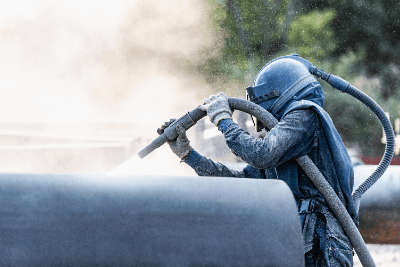All Categories
History

This section provides an overview for abrasive blasting as well as their applications and principles. Also, please take a look at the list of 1 abrasive blasting companies and their company rankings.
Table of Contents
Categories Related to Abrasive Blasting

Abrasive blasting, a surface treatment method, is widely used for metals. It involves directing abrasive materials onto the surface of products or materials using compressed air or similar techniques. This method is effective for smoothing surfaces, removing rust, coatings, scales, and creating a fine, uniform surface texture.
Abrasive blasting is adaptable to various materials, including metals, resins, and glass, and is especially useful for items with complex shapes. However, it may not be suitable for achieving mirror finishes due to the surface irregularities it creates.
Abrasive blasting is primarily used for cleaning, rust removal, paint stripping, and deburring. Its versatility, adjustable blasting intensity, and the availability of various abrasive materials make it suitable for a wide range of applications. It is also employed for peening to strengthen metals and for applying matte finishes for aesthetic enhancement.
Abrasive blasting functions in three main ways:
This method, which includes cutting, roughing, grinding, and polishing, selects abrasive materials based on the desired cutting amount and area. Hard and sharp-edged abrasives are preferred for large-scale cutting in a short time.
This involves removing debris, oil, dirt, coatings, burrs, and oxide films from the surface. Softer abrasives like nylon or copper are used to prevent product damage.
This process alters only the surface properties, using spherical abrasives to avoid material removal.
Abrasive blasting includes:
Sandblasting uses compressed air with abrasives for surface processing. Traditional sandblasting used silica sand, but now alternatives are preferred due to health concerns. This method is versatile, accommodating a variety of abrasive materials.
Shot blasting employs a high-speed wheel to project abrasives. Using steel shots, this method offers a broader range of abrasives than air blast and is efficient but produces shallower surface textures.
Grit blasting, similar to shot blasting, uses angular grains for higher abrasive power. Suitable for complex shapes, it is more expensive than sandblast and shot blast.
Choosing the right blast processing equipment and materials is critical. Incorrect choices can lead to surface irregularities, deformation, or residual material on the surface. Careful consideration of material types and processing order is essential.
*Including some distributors, etc.
Sort by Features
Sort by Area

Nicchu CO., Ltd, established in 1959 and based in Tokyo, Japan, is a manufacturer and supplier of surface processing equipment. The company's product range includes portable abrasive blasting machines, blast cabinets, shot peening machines, and dust collectors. These products play a pivotal role in surface treatment, cleaning, and enhancing material properties. They serve sectors like automotive, construction, electronics, and shipbuilding. Beyond equipment manufacturing, the company offers machinery maintenance, equipment rental, and technical support to its customers.
Number of Employees
Newly Established Company
Company with a History
*Including some distributors, etc.
| Country | Number of Companies | Share (%) |
|---|---|---|
 Japan
Japan
|
1 | 100.0% |
2 products found
2 products
Doi Kogyo Co., Ltd.
510+ people viewing
Last viewed: 5 hours ago
■Summary Doi Kogyo is the Japanese distributor of Germany's advanced blast surface forming tool manufacturer "Monty Power". A mechanism using a spe...
Doi Kogyo Co., Ltd.
580+ people viewing
Last viewed: 1 hour ago
■Summary Doi Kogyo is the Japanese distributor of Germany's advanced blast surface forming tool manufacturer "Monty Power". A mechanism using a spe...